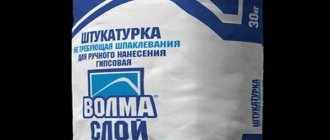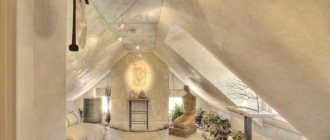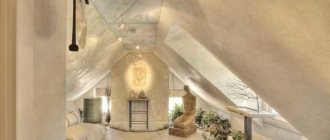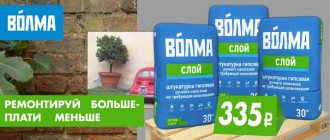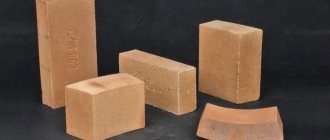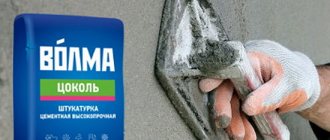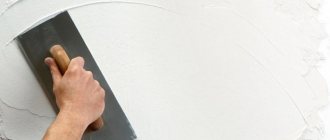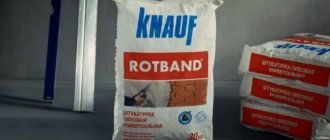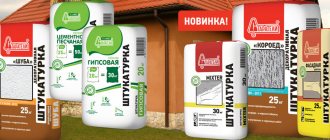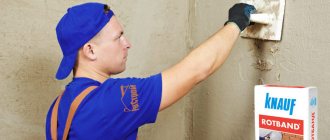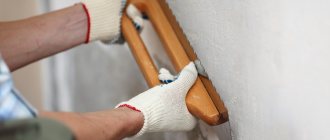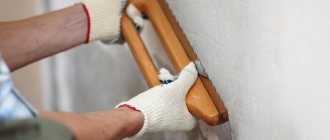Independence. This is the main installation for the Volgograd gypsum plant. He is 70 years old. The enterprise survived the restructuring only by increasing production volumes.
The plant's management avoided dependence on Western companies by not taking their capital for development. Volma represents 100% Russian products. The best seller is to buy plaster. Let's find out whether it evokes a feeling of pride for the country.
Instructions for dilution and application.
The preparation of Volma “Layer” gypsum plaster begins with studying the instructions. Here are essentially the usual steps; it is important to follow the proportions indicated on the packaging. To 1 kilogram of the composition add 600-700 milliliters of liquid. Considering that Volma gypsum plaster is packaged in 30 kg craft bags, it turns out that we need 18-21 liters of water per package.
To begin, pour some water into a convenient container (preferably plastic, it’s easier to work with) to wet the bottom and walls. The mixture is poured to the exact ratio of water according to the proportions. Mixing can be done using a trowel or trowel, but it is much more convenient (much easier for large volumes) to use a construction mixer or a trill with a special attachment. Tools will significantly save time and effort for quality work.
After stirring once, let the solution sit for about 3-5 minutes, this is the period of maturation of the components. After time has passed, stir the diluted mixture again until lumps are completely removed. The consistency should resemble thick sour cream, be plastic, but at the same time not flow off the instrument.
The gypsum composition in question can be used for minor repairs and major interior finishing. The limitation is due to the fact that gypsum, by its nature, absorbs moisture very well, so applying such plaster outdoors is a bad option.
The diluted composition is excellent for: plastering plasterboard, cellular concrete, reinforced concrete slabs, brick and wood.
This plaster is used for:
- restoration work, when minor defects are eliminated;
- minor repairs to level surfaces;
- capital finishing, when work is done from scratch;
- as a finishing coating for leveling before grouting with a sponge float
- creating decorative elements, arches, reliefs or sculptures.
After applying the finishing coat, immediately begin painting or laying ceramic tiles; surfaces coated with Volma “Layer” plaster allow this to be done.
Remember the recommendations on the packaging; the work room should be dry with a temperature range of 5-30 degrees above zero.
Note: If Volma gypsum plaster is applied in rooms with high humidity, then treat it with protective compounds. Do not allow water to come into direct contact with the plaster.
Nuances of operation
Before applying Aquastandard, carefully prepare the base. Initially, the coating, elements susceptible to shedding, and contamination (oil, bitumen, etc.) are removed. Otherwise they will prevent adhesion.
Pre-treatment of the base with one or two layers of primer of the same brand enhances the strength of fixation.
The dry composition is diluted with water in a ratio of 1 kg: 0.3 ± 0.05 l. To ensure homogeneity of the mass, the mixture is stirred for three minutes. Then it is allowed to “rest” for about five minutes, after which it is mixed again. To do this, use a special mixer or drill with an attachment with a speed of at least 400 rpm. The solution remains usable for approximately two hours.
The ratio of dry matter and water is maintained. Do not use other components to dilute the mixture instead of water.
Primer mixtures The main nuances of performing plastering work:
- The solution is applied with a metal spatula onto a previously prepared base. The layer is 0.1 - 0.3 cm. Defects formed during application are eliminated with abrasive materials, but after the coating has completely dried.
- Re-coating is performed after the first has hardened and primed;
- When finishing the facades, the freshly laid coating is protected from precipitation, cooling, and drying out for three days. Work should not be started in case of strong wind or rain.
Compositions for interior work
Although most mixtures for finishing facades have high performance characteristics and will definitely be able to function in more comfortable conditions in interior spaces, you should not buy them thoughtlessly. Firstly, some types of plaster have insufficient vapor permeability and can worsen the microclimate. Secondly and most importantly, they cost significantly more.
They expect completely different results from interior plaster, so it would be better to choose it according to the following parameters:
1. Light weight.
This requirement is fully met by compositions based on lime or gypsum. Both components are sensitive to moisture, so they can only be used in dry rooms. On the other hand, nothing better can be thought of for wooden bases.
2. Easy to use.
To fulfill this point, the manufacturers themselves tried to create ready-to-apply solutions, usually using polymer binders. The cost of such plaster is quite high, but it performs well as a remixture.
It will hardly be more difficult to work with dry compounds - they need to be mixed with water to obtain a viscous plaster solution. The most popular in this category are gypsum mixtures. In addition, it is a close relative, which means it is an ideal plaster for drywall, which allows you to save a lot on rough leveling of walls.
3. Minimum grain size.
If you do not take into account the decorative finishing, but consider the plaster as a leveling one, then the smallest fractions of the filler can be both an advantage and a disadvantage. It all depends on the condition of the surface
Price
Despite the excellent quality of the plaster, the price remains quite affordable for wide consumption. So, 1 kg of dry mixture costs approximately 10-12 rubles, in different cities it varies. To clearly see the cost of plaster, we provide calculations. For example, a room is 4 * 4 m, and the ceiling height is 3 meters, then we will need (4 * 3) * 4 * 9 (we take the maximum consumption) = 432 kg we need, this is approximately 15 bags of 30 kg, therefore, the total cost will be (if we take the cost of one 30 kg bag as 290 rubles - this is the average price in Rostov-on-Don) 4350 rubles.
Naturally, if your premises are smaller, then your costs will also be lower, both in terms of materials and finances.
Application sequence.
Leveling - having thrown the composition onto the wall, they begin to level it using a broad rule using beacons or without them when the wall is more or less even). The rule is from bottom to top, removing all excess and placing it on the recesses.
Trimming is carried out when the gypsum structure has set (after an hour) and acquired hardness. Similar to leveling, the rule cuts off small irregularities in individual areas, directing them into the remaining recesses. Already at this stage you can finish with plaster if your goal is to decorate with wallpaper or tiles. Remember to prime the surface before proceeding with the next type of work.
Smoothing is done with a grater with a sponge surface. It is recommended to start 20 minutes after trimming. After moistening the base with water, begin to move the grater over it until a “milk” forms.
You will immediately feel it when it appears, the friction will increase significantly and it will become more difficult to drive the tool. The resulting substance fills the microcavities and evens out the lunges.
Glossing is the final stage of processing. Here a grater with a metal plane is used. Essentially, the remaining defects on the gypsum surface are rubbed and compacted.
Maintain the full drying time indicated in the instructions; it depends on the temperature and ventilation of the room.
Decor on the surface.
You can decorate in different ways, from simple wallpapering to complex techniques of painting on dry plaster. It all depends on your preferences.
- The relief and texture can be set by special rollers. You can also even apply a relief pattern that can be selected on the roller rotor.
- The texture is also set with a simple spatula, alternately pressing on the weakly set gypsum solution. It turns out very beautiful.
- Decorative plaster can make many dreams come true, having a huge selection of options.
- Having the talent of an artist, take up your brushes and paints, create unique and inimitable patterns.
Important! Proceeding to the next stage after applying the plaster, be it wallpaper or tiles. Be sure to saturate the surface with primer, otherwise all your work will go down the drain. The primer will increase the adhesion of surfaces.
Specifications.
The diluted composition has:
- excellent adhesion;
- excellent vapor permeability, which affects air movement in the room;
- environmental friendliness - the basis is natural gypsum;
- no shrinkage.
The presence of good technical characteristics in Volma gypsum plaster has a positive effect on quality. Distinctive characteristics:
- working thickness from 5 to 30 millimeters;
- completion of setting within 3-4 hours;
- complete hardening within a week.
Undoubtedly, everyone has noticed that applying Volma Layer plaster to walls is very simple; you can do it yourself without resorting to the services of repair crews. This will significantly save your budget.
Positive sides
Let's consider the advantages of Volma-layer gypsum plaster, of which there are many:
- Easy to apply. Due to its plasticity, applying plaster does not require much effort.
- No shrinkage. Unlike other plasters, Volma-layer can be immediately applied in one layer up to 6 cm thick.
- There is no need for additional putty. Due to its structure, Volma-layer gypsum plaster has a glossy surface after drying and does not require finishing putty.
- Environmentally friendly product. The Volma company does not use harmful impurities in the manufacture of its products. Each package is stamped "ECOSTAMP".
- There is no need to pre-putty the walls. Volma-layer can be applied directly to a bare wall without treating it. The only condition is that the walls must be degreased, and metal objects must be treated with an anti-corrosion solution.
- Mixtures from the manufacturer Volma breathe.
Putty Volma – Seam
Headings:Volma, Putty
"VOLMA-Shov"
– a dry putty mixture based on natural gypsum binder, modified with mineral and chemical additives that provide high adhesion, water-holding capacity and optimal operating time.
Packing: 5 kg, 15 kg, 25 kg
“VOLMA-SHOV” SPECIAL GYPSUM PUTTER FOR SEALING gypsum board, gypsum board joints and leveling
Application area:
1. For sealing seams of plasterboard and gypsum fiber sheets with thinned edges using reinforcing tape.
2. To correct defects in plasterboard (GVL), cracks, potholes.
Plaster consumption.
Of course, material consumption depends on the curvature of the wall and the thickness of the layer. But, by default, based on the consumption of Volma plaster per 1 m2 with a layer thickness of 1 cm, you will need about 7.5 -9 kilograms.
It is not at all necessary to rely and take this as a basis, because there can be many factors influencing consumption. In order to avoid the mistakes of others, spend a little time on forums about Volma plaster where there are probably reviews about working with it.
Recommendation: Volma “Layer” gypsum plaster is purchased with a small reserve; this action will protect you in future from going to the store again when you are faced with minor surface modifications.
Preparing the wall.
You must first prepare the base for applying Volma plaster, otherwise you will get a bad result.
- Remove dust and dirt.
- Remove any remaining paint and loose pieces of plaster.
- Smooth out cracks and chips.
- Check the evenness of the wall with a level.
- If necessary, install leveling beacon profiles.
- Treat metal objects that are part of the base with an anti-corrosion agent.
Volma “Layer” gypsum plaster is applied to the bases manually using a standard set of tools:
- Different sized spatulas.
- Trowels made of different materials.
- Rule and falcon.
- Leveling floats.
The instructions indicate how to use Volma plaster with the listed tools. It is not worth diluting a lot of gypsum mixture at once, since the hardening period of the gypsum is 20-30 minutes. Calculate how much area you will have time to process during this time and, based on the consumption of Volma “Layer” plaster per 1 m2, mix the solution.
Professional opinions
People generally respond positively to putty. Consumers note high quality for a relatively small amount. The following video shows the quality of the work performed.
The packaging describes a detailed operating process, which helps during repairs. By following these recommendations, the final result is solid and attractive.
Manufacturers have indicated the ability to omit the puttying process. But builders who have tested the composition in practice note a slight graininess and advise not to neglect the finish. When working with the ceiling and wall slopes, a finely dispersed mixture is additionally applied.
Decorating artists also give positive descriptions of plaster. The homogeneity and softness of the mixture makes application simple and ensures quick drying and reliable fixation with the base.
Advantages
Among consumers there are opposing opinions about the products of this company. But it should be noted that the advantages outweigh the disadvantages.
Among the advantages are the following:
- frost resistance;
- good stickiness;
- environmental friendliness. Has environmental certificates and the “ECOSTAMP” stamp
- low consumption;
- moisture resistance;
- combination of reasonable price and excellent quality;
- ease of operation;
- can be used on various types of surfaces, both with and without subsequent finishing;
- obtaining a smooth glossy surface without puttying;
- regulation of the microclimate in the room (the surface breathes).
Other mixtures from the manufacturer.
Volma “Aquaslayer” plaster is a lighter fibrous composition with the presence of Portland cement, polymers and natural components. Like the composition we are considering, it is intended for leveling bases. Already from the name one can judge that it is hydrophobic and can be used in wet areas. Cement plaster Volma "Aquasloy" is used both inside buildings and on their exterior facade.
Compositions with a cement binder are often used as a primary layer, which serves as a reliable base:
- laying ceramic tiles;
- putty and decoration.
There are practically no restrictions on covering bases with Aqualayer; it can be cellular concrete, reinforced concrete products, floor slabs, wooden walls. Volma cement plaster “Aquaslayer” is packaged in 25 kg craft bags.
Scope of application
Volma brand building compositions can be selected for any situation. The range includes products for rooms with different types of humidity, including bathrooms, showers, kitchens, saunas and swimming pools. "Volma" is suitable for application on all types of building bases - brick, concrete, aerated concrete, gypsum plasterboard, foam concrete, chipboard, OSB, cement-lime coatings.
Plaster can be used to decorate different rooms, applied to walls, ceilings, partitions, niches, arches. Many products are suitable for facade work, cladding plinths, and unheated buildings.
